Safety Classification for I&C Systems in Nuclear Power Plants: Comparison of Definitions of Key Concepts
First published in September 2017 – Revised in 2019
The World Nuclear Association report, Safety Classification for I&C Systems in Nuclear Power Plants – Current Status & Difficulties, first published in 2017 by the Cooperation in Reactor Design Evaluation and Licensing Working Group (CORDEL), identified a number of key concepts which are important for the industry to understand and implement correctly in order to meet licensing requirements, but which are often vaguely or inconsistently defined by regulatory bodies.
Where requirements are not clearly defined, there is room for different interpretation. Divergent understanding could have a significant impact on the duration of a nuclear project’s lifecycle.
The safety classification report identified the following five concepts as frequently causing problems in the interpretation of requirements:
- Defence-in-Depth and Diversity
- Separation (physical separation / electrical isolation / functional independence / independence of communication)
- Redundancy
- Reliability/Availability
- Spurious Activation (inadvertent actuation of I&C functions).
The concept of Independence was added to this list of concepts to be reviewed, as several of the terms stated in the first safety classification report dealt with various aspects of Independence.
Each of the above concepts is defined by a series of terms and associated definitions in different regulatory documents and reference codes & standards. As long as there is no harmonized understanding for such top-level concepts there will be a risk of misunderstandings in every project, which may lead to conflicts with contractual requirements or issues with regulatory conformance.
This report compares the various definitions by:
- Identifying all the terms that are associated with the key concepts
- Highlighting any inconsistencies in the different regulatory bodies’ definitions of these terms.
This 2019 revision of the report was prepared to address comments on the 2017 version provided by the Nuclear Energy Agency's Committee on Nuclear Regulatory Activities' Working Group on Digital Instrumentation and Control (NEA CNRA WGDIC). As a result several errors were corrected, recommendations for bringing more consistency to international terminology were expanded, and the terminology given for the Finnish regulator was updated to take account of changes that were incorporated into the Finnish Decree 717 released in 2013. This Decree brought the definitions of the terms studied in the report closer to those used by other nuclear regulators.
